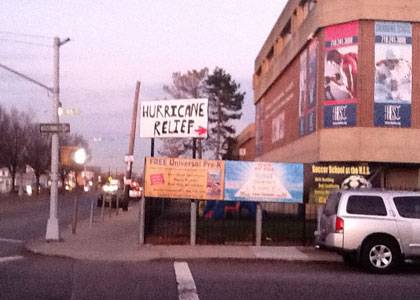
With a flooded apartment and an infant with bronchitis, the downtrodden woman on the Brooklyn street corner clearly needed help.
But in the chaos following Hurricane Sandy last fall, the woman seemed incapable of finding aid, and voiced this frustration in an interview with Duke graduate student Sancha Medwinter.
The interview was conducted beneath a sign, directly above the woman's head, that read "Hurricane Relief" and pointed to a nearby relief station.
"The place was literally one building over from where she was standing," Medwinter recalled.
This apparent information disconnect is the subject of Medwinter's dissertation. A doctoral student in sociology, Medwinter headed to New York City soon after the hurricane hit last fall, sensing it would be a fertile laboratory for her study of social capital and the ways people seek help in times of need.
Her initial suspicions were that people with little money and other resources would have difficulty seeking help outside those they know. Even with all manner of help available, many people don't seek help even from those they know or don’t find help directly from agencies -- even if it's right in front of them.
"This notion of people seeking out help in times of need isn't really playing out," Medwinter said. "In a disaster situation, people are just not acting in expected ways. Some people who need help don't ask because they are comparing their loss to that of others who seem worse off than them. Many more don't ask because they feel they cannot handle any additional stress."
Medwinter received her bachelor's degree from Brooklyn College, so she knows the territory affected by the hurricane. She headed to New York 10 days after Sandy hit and has zeroed in on two neighborhoods to study -- Far Rockaway, in Queens, and Canarsie, in Brooklyn. She has canvassed both neighborhoods on four separate occasions, knocking on doors, interviewing residents and filming the cleanup.
'It was an unfortunate but opportune situation where she was able to combine her theoretical work with some very real situations," said Nan Lin, a Duke sociology professor and Medwinter's adviser. "She was familiar with the area so she could launch her research quickly."
Medwinter has talked to about 60 residents and emergency workers so far and has been struck by how paralyzing the stress can be on those struggling to recover. Medwinter recalls a Far Rockaway business owner whose print shop was severely damaged. A relief center one block away offered help. All he had to do was go in and fill out some documents.
He couldn't do it.
"He needed to show some paperwork," Medwinter recalled. "And it just seemed insurmountable to him."
Instead, he did the cleanup himself.
Prior to the hurricane, Medwinter's doctoral work focused on labor market outcomes in the same New York City neighborhoods. Her focus has shifted significantly now, and she hopes to eventually produce a documentary and other research that could help emergency relief organizations fine-tune their disaster response efforts. She points to gaps she's found in the services provided, like a lack of data collected at relief stations that could help workers better map where needs are greatest.
"When you're in crisis mode, the instinct is to give," she said. "But they should also be collecting information and processing it with immediate turnaround."
Medwinter's research will likely have both theoretical and practical applications, said Lin, her adviser. Her findings will bolster current academic literature on social capital and the way people deal with stress, Lin said. And he too thinks her work can be put to practical use by service agencies looking to better connect with needy victims of natural disasters. He points to the gap still existing in places ravaged seven years ago by Hurricane Katrina.
"On the one side, there are needs, and on the other side, plenty of services," he said. "And they don't match up."